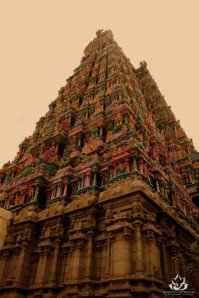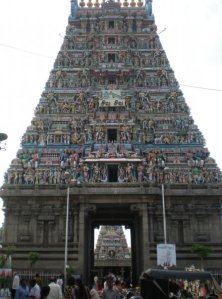
Money makes the world go around, and nowhere is that saying truer than in India. From the moment I arrived at my hotel in Chennai, right up to the time I checked in at the airport to fly home, I found myself constantly having to dole out money for things that I would not have to pay for here in Malaysia.
TIP EM!
Tipping is not just the norm in India, it's the culture. As a foreigner, especially one from a country with a higher currency rate, you are expected to tip your way through your trip. If you fail to tip somewhere along the line, expect to be treated in an uncooperative manner and worse still be insulted.
For instance if you forget to tip the guy at the shoe counter at some tourist area, be prepared to hear audible grumbling about stingy foreigners. This despite the fact that you had already paid to deposit your shoes there. In short you will be expected to dish out extra money for whatever service you request.

That aside, there will always be helpful wannabes tagging behind unsuspecting tourists and expecting to be tipped for their apparent helpfulness. For instance when my family and I were strolling in the gardens of the Rajiv Gandhi Memorial, one of the security guards kept tagging behind us and droned on like a tour guide. At first we were a bit puzzled as to his behaviour, it took us awhile to realise that he expected to be tipped. We gave him 20 rupees and he ambled off. When we told our driver about it, he said 20 rupees was actually too little. He chuckled and said it was likely that the guy was not too happy with his tip.
To an extent that sort of behaviour is to be expected when it comes to porters, waiters, guards etc. But what of priests? Though I have heard horror stories from friends and relatives alike about the way temples in India are run, it was nothing like experiencing it in person.
The avaricious attitude displayed by the majority of the temple priests I encountered, literally puts that of 3rd world politicians and bureaucrats to shame. More so that such vulgarity was blatantly practiced before the inner sanctum of some of the most holiest and revered shrines in Hinduism.
For anybody planning to go on a temple tour of India, start saving now! you have been warned. My mum and I spent more in the six or more temples that we visited than we did shopping for gifts!

What you have to pay for when visiting a temple:
1. Entrance fee. ( For the smaller temples it's a standard fee, while for the bigger temples there are different fees for different entrances. The special entrance fee is the most expensive - priced at about 100 rupees at an average, it will enable you to go right before the inner sanctum of the deity for about five minutes.
2. You might also have to pay for depositing your footwear outside the temple.
3. Camera ticket if the temple allows cameras in.
4. Fees for the various prayers you might want the priests to perform. The most basic being the "Archanai" fee.
5. Fees for bringing special items for the deities like a sari for instance.
6. Guide fees for the larger temples which are of historical interest.

Now that's just the standard stuff you have to pay for. The real rip-off starts when you reach the area of the inner sanctum. To recount what happened at all the temples we visited would be too many. For the purpose of this post, I shall describe what happened at the Meenakshi Amman Temple in Madurai as an example.
After paying a host of fees for my brother's camera, 100 rupees each for the special entrance tickets etc, we made our way to the special entrance gate, after queuing for about 20 minutes, we reached the gate leading to the inner sanctum of Goddess Meenakshi, and were ushered in by the security personnel (All major temples in India employ a high level of security thanks to bomb threats).
Two things struck me when I entered the gated area of the inner sanctum, one was the beauty of the Goddess herself, a tall life-size black statue of a woman clad in an emerald green sari, with her gold ornaments glinting by the light of the lamps lit in her sanctum. The other was that the place was a veritable marketplace! the din was unbearable, certainly not an atmosphere for quiet contemplation.
As we stood looking a bit dazed, several priests called out to us to come closer, when we approached them, a priest put a tray with the holy ash and "arati" (holy fire) before us and said: " Please put 500 rupees or 1000 rupees on the tray". When we appeared reluctant, he rattled off like a tour guide, telling us how much the gold ornaments on the Goddess weighed, how tall was her statue etc, and then looked at us expectantly again, we put down 100 rupees, he looked at the money, gave a satisfactory nod and left. The thing is he was not the only one doing that, all around us we could hear priests saying: "500 rupees, 1000 rupees".
We then proceeded to the inner sanctum of Lord Shiva to have a repeat performance of what happened earlier. This time my brother put about 50 rupees on the tray, the priest walked into the inner sanctum, picked up the rolled-up note from the tray, saw that it was only 50 rupees, came out again, approached us as we were praying and said: " Can you please put more money on the tray? we will use it to feed the poor Brahmans." My brother put down another 10 rupees, and he walked off, waiting to milk another more generous tourist I suppose.
My mum and I had a similar experience at the Kanyakumari Temple. A priest who guided us to the special entrance gate, actually requested a tip for his 'apparent helpfulness'.
When we told our driver about this, he said that despite being paid regular salaries, the majority of temple priests in India, especially those in the bigger temples, are out to make a quick buck from tourists. He said the way they see it, tourists like us come from countries with higher currency rates, so there's no harm in us parting with say 1000 rupees for the good of temple folk like them.
He also said that on the whole the priests would try to encourage people who want to donate money, to put the cash on the tray instead of the huge donation boxes that are a fixture at almost all temples. This is because the money put in the iron boxes comes under the purview of the government and will be used for the upkeep of the temple, while money put on the tray goes into the pockets of the avaricious priests.
We were also told that the priests were particularly upset that the government made a ruling forbidding non-Hindus from entering the area of the inner sanctum itself. Why? because this means they would not be able to seek donations from Western tourists ( apparently deemed to be more generous). We were naturally quite shocked, in any religion as we know it, only devotees and those of the faith are allowed before the sacred shrines to worship. And to think that these priests who are supposed to be the guardians of the sacred sanctuaries so to speak, would not mine having gaping tourists with cameras access into such hallowed ground just for $$$$.
WHERE IS ALL THAT MONEY GOING TO?

Throughout my 10 day stay in India, one thing was glaringly apparent, the lack of cleanliness. Sadly this also extended to the temples. So many priests hanging around to make a quick buck from tourists, but no time to clean the shrines properly? walking around the Kapaleeshwarar Temple in Mylapore, Chennai, I was quite shocked to see grime and dirt on the walls of some of the shrines.
At the Madupuram Kali Temple on the outskirts of Madurai, the huge statue of the great Goddess herself looked like it needed a good scrub, even the red sari draped about her torso had smudges of dirt on it.
Of all the temples I visited, the Vaitheeswaran Temple near the famed temple town of Chidambaram was in a most appalling state of neglect. Only the front portion of the temple had some form of lighting, everywhere else was pitch dark. We literally had to grope our way through the passages of this ancient temple, to make it worse, the floor was slippery and muddy to boot!
We Hindus have this thing about brightness, especially with regards to altars and places of worship. Bright means auspicious, that being the case, it was quite sad to see some of the shrines looking dark and dingy with only one small flickering oil lamp. In fact at some of the shrines, we did not even know which god we were praying to. It was that dark.
Millions of tourists flock to India each year to visit her ancient temples. In short the temples are a huge draw. Yet so little is done to keep these buildings in good order. Lack of money is not an issue, the temples receive huge amounts of donations from tourists and devotees alike.
While in Madurai, our driver showed us a newspaper article about the donations received by a famous temple to Lord Vishnu somewhere in Karnataka, there was an accompanying picture to the article which showed stacks and stacks of rupees which government workers were taking out of the donation box. So where is all the money going to? No doubt the government does allocate a certain amount of money for the upkeep of the temples. But more should be done.
Taking all this into account, will I visit India again to see her ancient temples in the not so glorious state that it is in today? Indeed I will, corrupt priests not withstanding. Why? despite all the rupees that I have to dole out and all the silly tickets I have to purchase, and the dirt and neglect, there is a certain something about these ancient monuments that's special.......centuries of worship does add character to a place. I am sure all those people who flock to India year after year without fail, will agree with me.
Comments